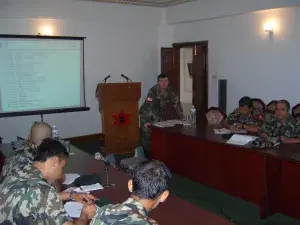
True or false: You’ll never encounter a foreign intelligence officer during your time employed with TSA, and if you do, you are of no value to them.
TSA Senior Intelligence Analyst Dwayn Hanford from the Transportation Analysis Division (TAD) of Intelligence & Analysis (I&A) will give you an A+ if you answered false to that question.
Hanford drives home the point by recounting a chance meeting he had on a Ronald Reagan Washington National Airport shuttle bus waiting to move from the terminal to the aircraft.
“The chatty individual noted he once had access to classified information as a government contractor, and he joked to me about the security briefings he had to go through,” said Hanford. “He stated how serious the briefs were as if there were intelligence officers everywhere. I remained silent and laughed to myself because yes there are, and he was telling this story to one.”
With 23 years of active military duty and 10 additional years as an Army intelligence civilian, Hanford is particularly suited for his current task of leading the analytical effort of TAD by managing production, mentoring junior analysts and providing intelligence information to the global TSA mission of counterintelligence activities.

“My time stretches from the Cold War to the global war on terror to hybrid threats of cyber and information warfare,” explains Hanford. “This knowledge and leadership of the many changes in intelligence focus and processes make me unique to TSA because I know threat trends over three decades, and I am current on today’s threats.”
As Hanford focuses on Counterintelligence Month, he wants everyone to be clear about what could happen if our adversaries piece together damaging information gleaned from unsuspecting TSA employees.
“The effects of foreign intelligence entities’ success in collecting all the pieces needed for their goals can range from identification of TSA practices, employee vulnerabilities, physical infrastructure vulnerabilities or possibly severe effects such as recruitment or death,” warns Hanford. “A tiny detail such as a list of employees may offer insight into potential placement and access. This unclassified list of personnel can be used with social media to identify personnel with access to information that may be susceptible to hostile intelligence agency exploitation.”
Another myth Hanford dispels is that only the CIA has counterintelligence officers. Although the CIA is by far the most well-known in the industry, TSA Counterintelligence collaborates with multiple agencies including the CIA, the FBI, DHS, FAA and the Department of Defense. Hanford’s latest project looks at the way TSA views counterintelligence threats.
“Intel agencies and the Department of Defense have clear methods to identify adversarial threat levels ranging from low to high,” said Hanford. “From a counterintelligence perspective, TSA has relied on these other agencies to assess this threat. I have worked with members of the Counterintelligence branch to draft counterintelligence threat level mythology that will soon allow TSA to rank our threats based on criteria that is specific to TSA. This will provide clearer focus on what is important to us as we travel to foreign nations or deal with foreign personnel visiting us in our TSA facilities.”
Joining TSA on September 11, 2022, Hanford models the servant leadership style. Enthusiastic about mentoring others, he has committed a large portion of his extracurricular time to furthering talent within the industry.
“At American Military University, I teach courses in Intel Analysis, Collection, Forecasting Terror, Threat, and Open Source Intel. In 2016, as a Trustee of the Excelsior University Board of Trustees, I successfully lobbied for the creation of the National Security undergraduate program and started teaching the Intro to National Security, Intelligence Support to Policymaking, and Capstone courses. I have instructed over 2,500 students and mentored many into graduate programs or helped them find careers in the Intelligence Community.”

Hanford currently serves as the vice president of the National Intelligence University Alumni Association.
What I do matters
“The Foreign Intelligence Entities (FIE) from our adversaries have become much more technologically capable and have grown in numbers and intentions to collect on TSA personnel. I provide the intelligence data on the FIE threat to I&A leadership and to TSA counterintelligence officers in support of their efforts to defend TSA information, facilities and personnel.
“An overlooked consideration for many in TSA is their understanding of the threat. FIE will target any member of TSA because of their position in the U.S. government. Many are unaware that they may have information our adversaries need, even if it is only a small part of the TSA mission. My role seeks the adversarial capability and intent to collect this information and/or target TSA personnel so that our counterintelligence officers can engage in actives to thwart hostile efforts.”
By Karen Robicheaux, TSA Strategic Communications and Public Affairs
